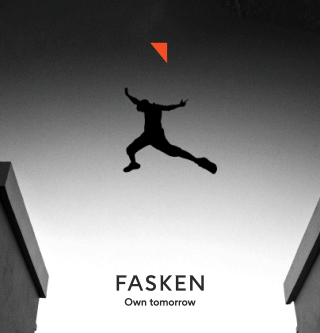Technology
Mapped: Interest in Generative AI by Country
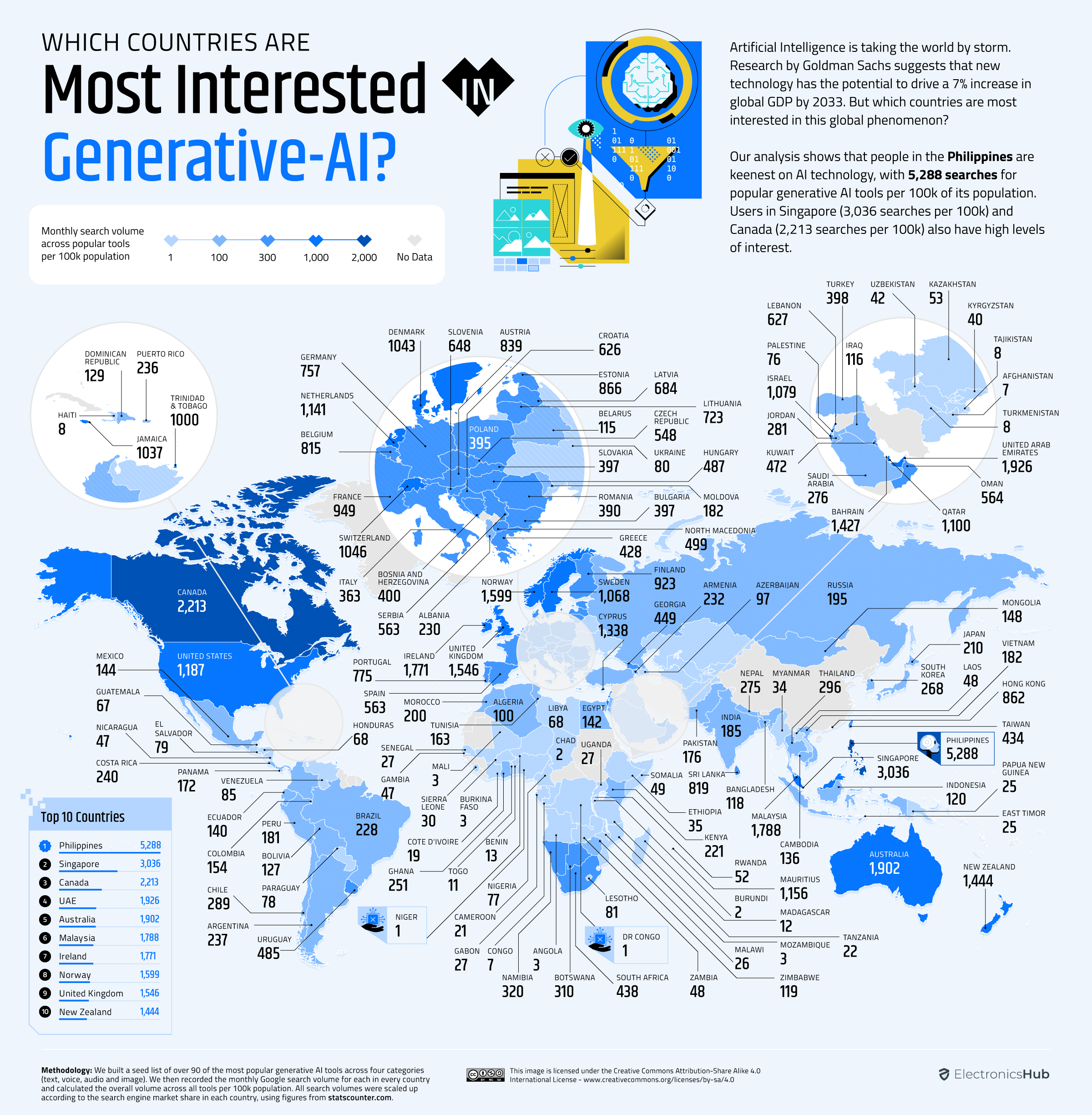
Mapping Interest in Generative AI by Country
In the past two years, AI’s ability to produce text, images, audio, and video has become massively widespread.
With millions of people worldwide now embracing tools like ChatGPT and Midjourney to bring their ideas to life, billions of dollars are being invested to take AI technology to the next level.
But so far, AI interest by country varies, at least according to search data. This graphic sheds light on the countries most interested in generative AI tools using data compiled by ElectronicsHub.
Search Interest in Generative AI by Country (2023)
To determine interest in different generative AI technologies, ElectronicsHub first determined the top 10 tools in each category based on their global monthly search volumes.
They then recorded the monthly Google search volumes for each tool, combined the overall volumes of each country, and scaled the results by population (per 100,000 people) and Google’s search engine market share in each respective market.
According to the compiled data, the highest search volume for generative AI tools was seen in the Philippines (5,288) followed by Singapore (3,036) and Canada (2,213).
Let’s take a closer look at the different generative AI tools nations worldwide seem to prefer.
Generating Text with AI
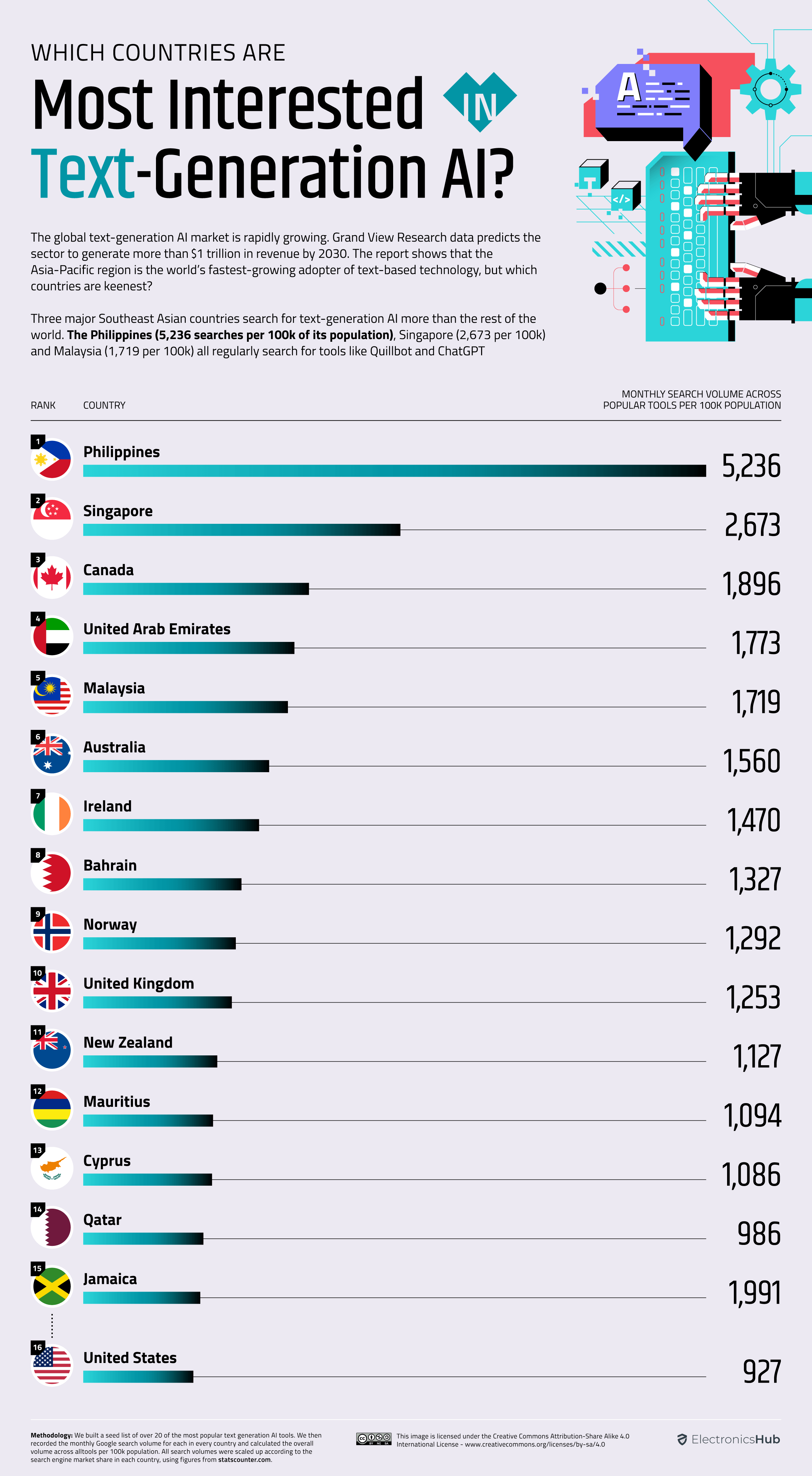
The launch of ChatGPT last year turned the world’s attention to the world of generative AI. However, some tools, like QuillBot, have helped users check grammar, edit, and summarize text for over five years.
Generative AI tools used for tasks ranging from drafting emails to creating job application packages have been most sought after in Asian nations like the Philippines, Singapore, Malaysia, and other parts of the world including Canada, and the UAE.
Generating Images with AI
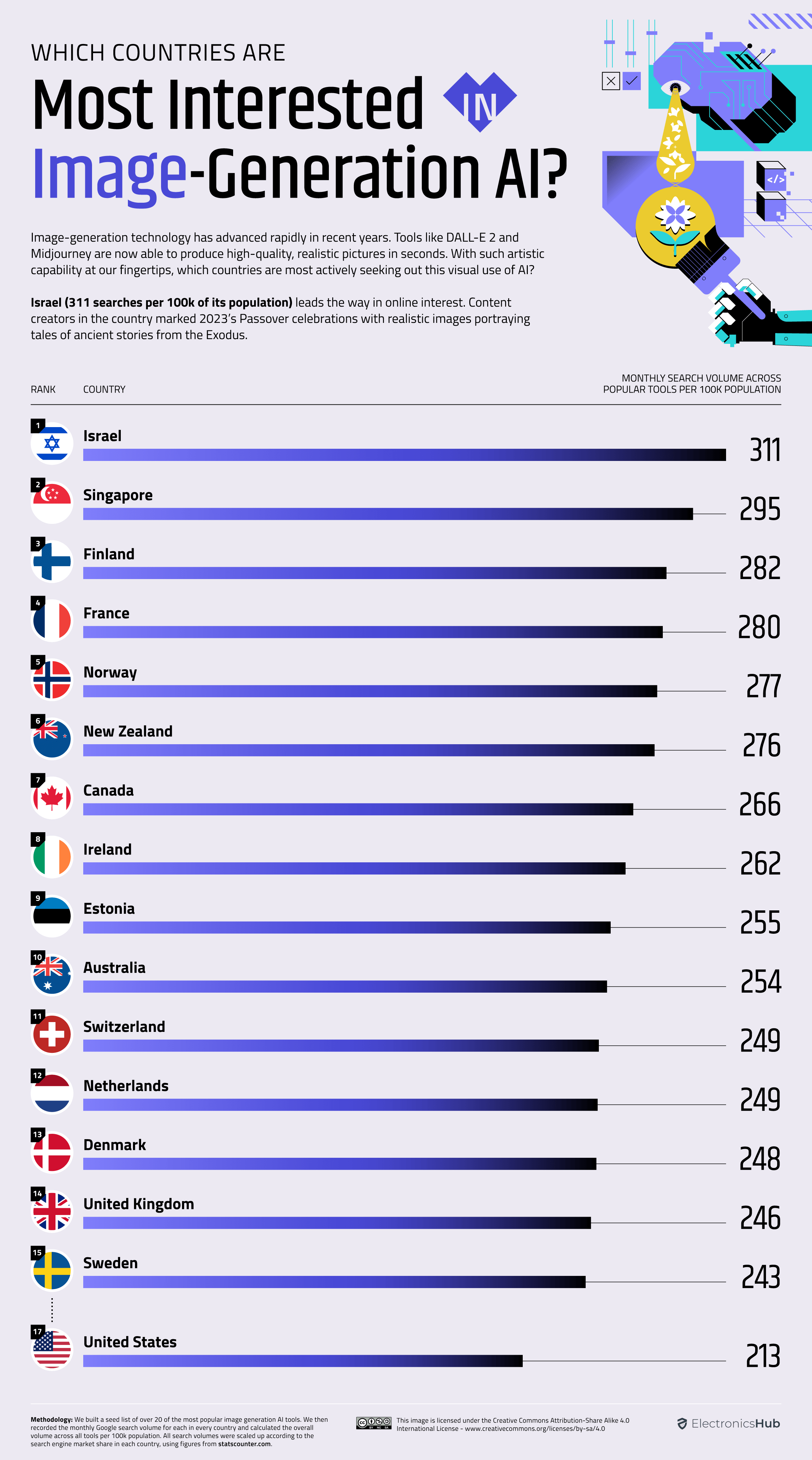
A picture speaks a thousand words. And the launch of generative Image AI tools like DALL-E 2, Midjourney, and Stable Diffusion have created a whole new world of storytelling. Once used only by designers, these text-to-image tools are now being used in science and medicine.
Israel and Singapore, the two nations leading the global interest in generative image AI, seem to prefer using Midjourney, the most-searched tool in 92 nations worldwide.
Generating Audio with AI
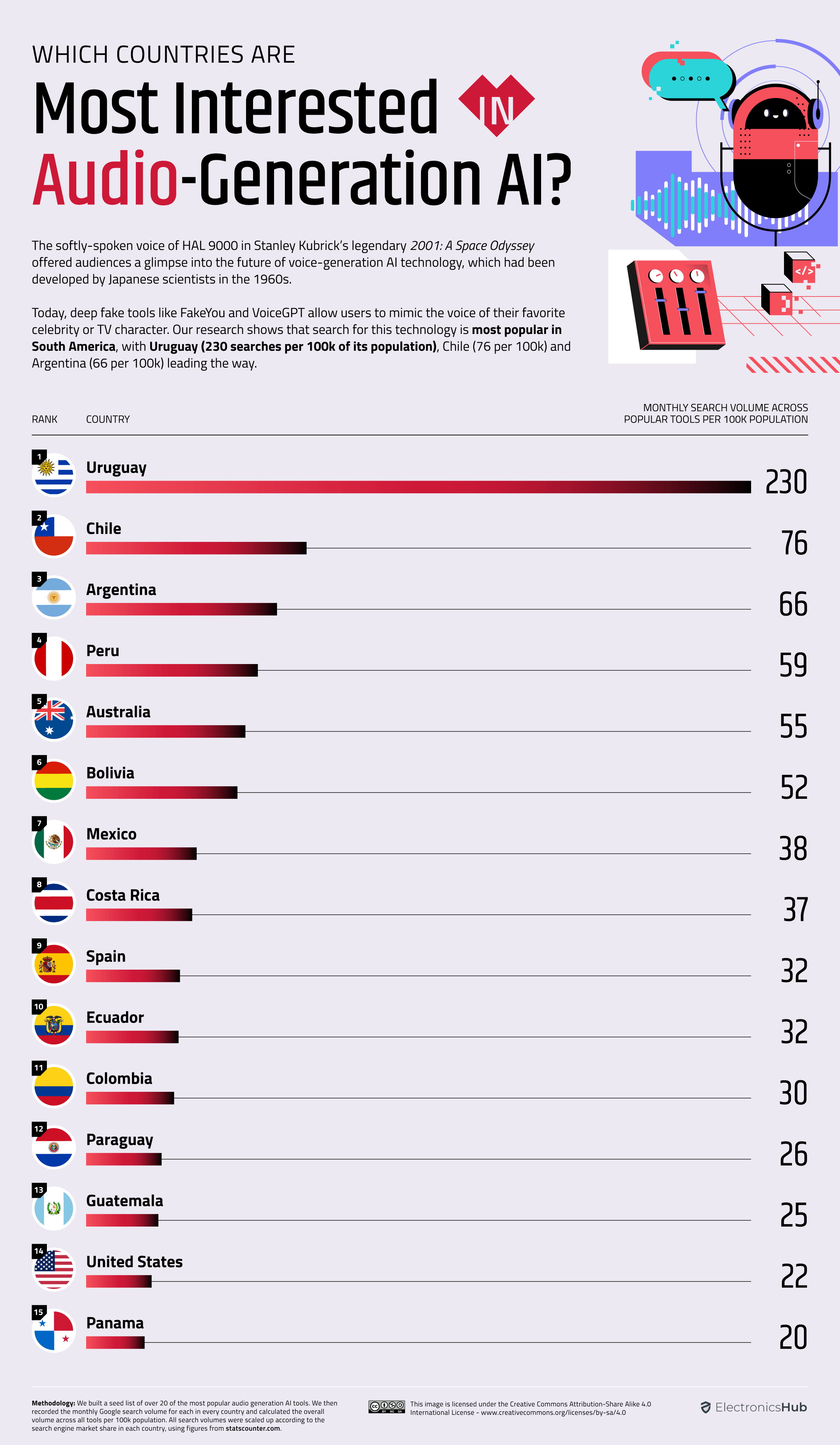
While the use of generative AI is not as established in audio generation, it has already begun making its mark. From its uses in voice-to-text transcription platforms to the music industry, generative AI in audio is growing worldwide.
While this may pose challenges in the music industry, tools like FakeYou and VoiceGPT, which allow mimicry of the voices of celebrities and artists, are growing increasingly popular in the South American nations of Uruguay, Chile, Argentina, and Peru in 2023.
Generating Video with AI
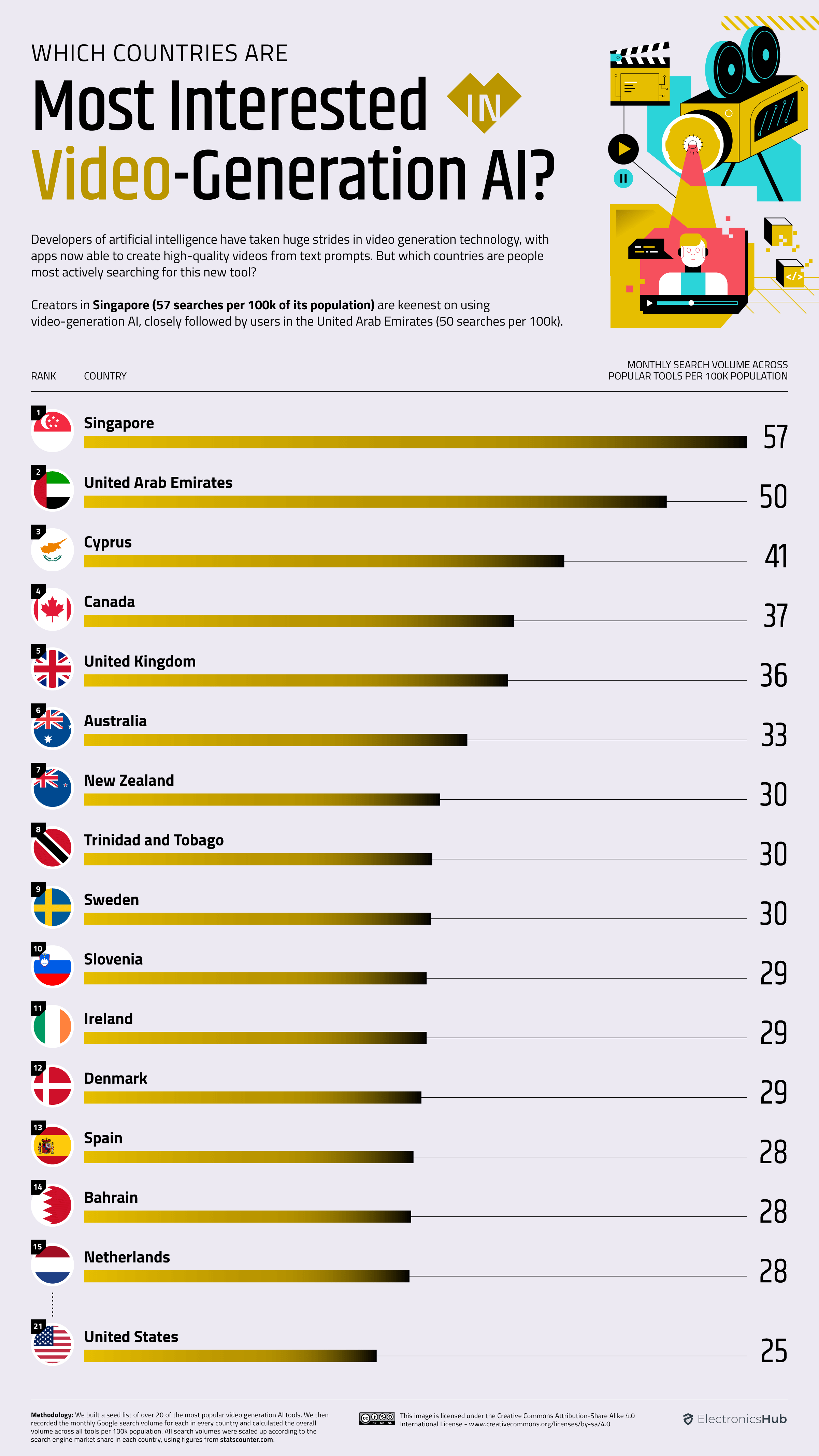
From movies and TV shows to TikTok reels and YouTube content, videos are often the fastest way of capturing an audience’s attention. Despite this, generative AI’s video generation tools are not as developed as other generative media tools, yet.
While nations including Singapore and the UAE are searching the most for video-generation tools like InVideo and Synthesia, the world is looking for what emerges next in this field.
Generative AI is Just Starting Out
Much like how the printing press changed the way we disseminate information, generative AI is revolutionizing the way we produce and use information.
As the world of generative AI blurs the line between what’s real and what’s not, and what’s fake and what’s true, an intriguing path unfolds.
While businesses and users seek to harness the full potential of AI, governments and lawmakers are simultaneously grappling with the challenge of comprehending its regulation to curb potential drawbacks and misuse.

This article was published as a part of Visual Capitalist's Creator Program, which features data-driven visuals from some of our favorite Creators around the world.
Technology
All of the Grants Given by the U.S. CHIPS Act
Intel, TSMC, and more have received billions in subsidies from the U.S. CHIPS Act in 2024.

All of the Grants Given by the U.S. CHIPS Act
This was originally posted on our Voronoi app. Download the app for free on iOS or Android and discover incredible data-driven charts from a variety of trusted sources.
This visualization shows which companies are receiving grants from the U.S. CHIPS Act, as of April 25, 2024. The CHIPS Act is a federal statute signed into law by President Joe Biden that authorizes $280 billion in new funding to boost domestic research and manufacturing of semiconductors.
The grant amounts visualized in this graphic are intended to accelerate the production of semiconductor fabrication plants (fabs) across the United States.
Data and Company Highlights
The figures we used to create this graphic were collected from a variety of public news sources. The Semiconductor Industry Association (SIA) also maintains a tracker for CHIPS Act recipients, though at the time of writing it does not have the latest details for Micron.
| Company | Federal Grant Amount | Anticipated Investment From Company |
|---|---|---|
| 🇺🇸 Intel | $8,500,000,000 | $100,000,000,000 |
| 🇹🇼 TSMC | $6,600,000,000 | $65,000,000,000 |
| 🇰🇷 Samsung | $6,400,000,000 | $45,000,000,000 |
| 🇺🇸 Micron | $6,100,000,000 | $50,000,000,000 |
| 🇺🇸 GlobalFoundries | $1,500,000,000 | $12,000,000,000 |
| 🇺🇸 Microchip | $162,000,000 | N/A |
| 🇬🇧 BAE Systems | $35,000,000 | N/A |
BAE Systems was not included in the graphic due to size limitations
Intel’s Massive Plans
Intel is receiving the largest share of the pie, with $8.5 billion in grants (plus an additional $11 billion in government loans). This grant accounts for 22% of the CHIPS Act’s total subsidies for chip production.
From Intel’s side, the company is expected to invest $100 billion to construct new fabs in Arizona and Ohio, while modernizing and/or expanding existing fabs in Oregon and New Mexico. Intel could also claim another $25 billion in credits through the U.S. Treasury Department’s Investment Tax Credit.
TSMC Expands its U.S. Presence
TSMC, the world’s largest semiconductor foundry company, is receiving a hefty $6.6 billion to construct a new chip plant with three fabs in Arizona. The Taiwanese chipmaker is expected to invest $65 billion into the project.
The plant’s first fab will be up and running in the first half of 2025, leveraging 4 nm (nanometer) technology. According to TrendForce, the other fabs will produce chips on more advanced 3 nm and 2 nm processes.
The Latest Grant Goes to Micron
Micron, the only U.S.-based manufacturer of memory chips, is set to receive $6.1 billion in grants to support its plans of investing $50 billion through 2030. This investment will be used to construct new fabs in Idaho and New York.
-

 Sports1 week ago
Sports1 week agoThe Highest Earning Athletes in Seven Professional Sports
-

 Countries2 weeks ago
Countries2 weeks agoPopulation Projections: The World’s 6 Largest Countries in 2075
-

 Markets2 weeks ago
Markets2 weeks agoThe Top 10 States by Real GDP Growth in 2023
-

 Demographics2 weeks ago
Demographics2 weeks agoThe Smallest Gender Wage Gaps in OECD Countries
-

 United States2 weeks ago
United States2 weeks agoWhere U.S. Inflation Hit the Hardest in March 2024
-

 Green2 weeks ago
Green2 weeks agoTop Countries By Forest Growth Since 2001
-

 United States2 weeks ago
United States2 weeks agoRanked: The Largest U.S. Corporations by Number of Employees
-

 Maps2 weeks ago
Maps2 weeks agoThe Largest Earthquakes in the New York Area (1970-2024)












